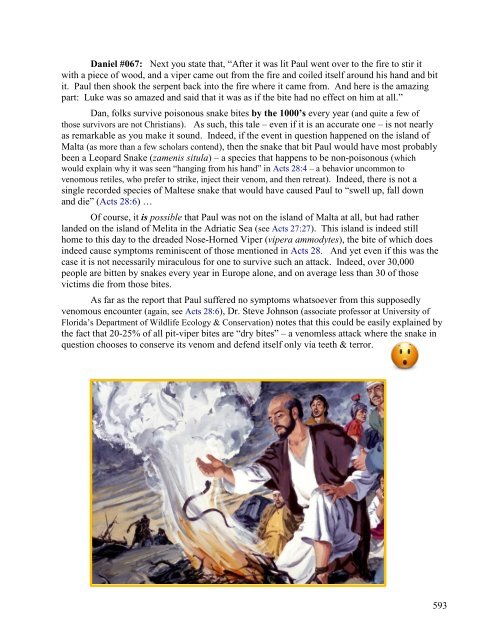- Page 1 and 2:
Burnishing Bigotry … a multi-voic
- Page 3 and 4:
Dedicated to all sincere Seekers of
- Page 5 and 6:
Chapter 040: Dialogue #27 - Satan
- Page 7 and 8:
Introduction Welcome to ―Burnishi
- Page 9 and 10:
Why I have released it as a Book
- Page 11 and 12:
A few useful TIPs on how to use thi
- Page 13 and 14:
TIP #04] Reading around the “Spew
- Page 15 and 16:
Dialogue #01 … And so it Begins B
- Page 17 and 18:
17
- Page 19 and 20:
Bart: Question: Do you, Vanessa or
- Page 21 and 22:
P.S. Bart, I will admit that you ha
- Page 23 and 24:
ONE) Seeing as how there is clearly
- Page 25 and 26:
Lucy #003: Then you mention your pe
- Page 27 and 28:
*In Matthew 6:25-26 & Matthew 26:31
- Page 29 and 30:
*In Matthew 15:21-28 Jesus over-rid
- Page 31 and 32:
*In Matthew 21:40-43 Jesus indirect
- Page 33 and 34:
Lucy #006: Next you make the common
- Page 35 and 36:
Lucy-Spew #02 … What GOD Wants Lu
- Page 37 and 38:
Lucy #009: Later you state that,
- Page 39 and 40:
Lucy #011: You later state that God
- Page 41 and 42:
Lucy #013: Then you continue on by
- Page 43 and 44:
Lucy #017: You next state (without
- Page 45 and 46:
Lucy-Spew #03 … God’s condition
- Page 47 and 48:
*And yet in response to this discre
- Page 49 and 50:
Lucy #021: Leaving aside for now th
- Page 51 and 52:
Lucy-Spew #04 … Reveling in Revel
- Page 53 and 54:
Lucy #024: You then state that ―G
- Page 55 and 56:
Lucy #027: And next, as far as your
- Page 57 and 58:
*In those same two verses (Revelati
- Page 59 and 60:
*Revelation 21:10 & Revelation 21:2
- Page 61 and 62:
*Question #03) “What was Jesus' P
- Page 63 and 64:
Dialogue #04 … Beth’s Abominati
- Page 65 and 66:
Thirdly & finally, it is critical t
- Page 67 and 68:
Lucy-Spew #05 … da Bible’s main
- Page 69 and 70:
Lucy #030: You then state - among m
- Page 71 and 72:
Lucy #032: Thereafter, you state th
- Page 73 and 74:
Lucy #035: Next you claim that, ―
- Page 75 and 76:
Lucy #037: You then you continue by
- Page 77 and 78:
Lucy #039: Finally, you allude to 1
- Page 79 and 80:
*A study released in May 2006 by Sw
- Page 81 and 82:
POINT #02) Levitcus, Be Damned …
- Page 83 and 84:
Bart: Love is the foundation of goo
- Page 85 and 86:
Vanessa: What about God's other law
- Page 87 and 88:
Bart: Vanessa, calling me a bigot i
- Page 89 and 90:
Lucy #040: You start by stating,
- Page 91 and 92:
Lucy #044: Next you claim that, ―
- Page 93 and 94:
Lucy #047: Thereafter you do essent
- Page 95 and 96:
Lucy #050: You then further entrenc
- Page 97 and 98:
Lucy #052: Finally, you conclude th
- Page 99 and 100:
Lucy-Spew #07 … re-Membering Sin
- Page 101 and 102:
Lucy #054: You then state that, ―
- Page 103 and 104:
Lucy #056: Thereafter you sink deep
- Page 105 and 106:
Lucy #059: Penultimately, you say t
- Page 107 and 108:
Intermission #01 … Returning to S
- Page 109 and 110:
[By the way, in case anyone out the
- Page 111 and 112:
Scaughdt: Lucy, what does being bor
- Page 113 and 114:
Lucy: That is you, Scaughdt! … I
- Page 115 and 116:
Lucy: LOL ..... Scaughdt, you can't
- Page 117 and 118:
Scaughdt: Excellent, my Friend! You
- Page 119 and 120:
Dialogue #11 … The Arrival of Dia
- Page 121 and 122:
*In 2005, Dr. Brian Mustanski of th
- Page 123 and 124:
Dialogue #12 … Daniel’s un-Gran
- Page 125 and 126:
Dialogue #13 ... my Fourth Question
- Page 127 and 128:
Vanessa: ―It is not cool to be a
- Page 129 and 130:
―When we think about our sins, we
- Page 131 and 132:
Lucy: Vanessa, we are not comparing
- Page 133 and 134:
Lucy #062: You then note that, ―W
- Page 135 and 136:
Lucy #065: You continue by saying,
- Page 137 and 138:
Lucy #068: Then you (and Steve Shir
- Page 139 and 140:
P.S. By the way, assuming that by
- Page 141 and 142:
Scaughdt: OK, Lucy! There truly are
- Page 143 and 144:
Lucy #072: You then go on to claim
- Page 145 and 146:
Lucy #075: Thereafter you go on to
- Page 147 and 148:
Lucy #077: And then you cite more f
- Page 149 and 150:
Lucy #081: You then quote Koenig fu
- Page 151 and 152:
Lucy #083: You then continue using
- Page 153 and 154:
Lucy #085: Lastly, you essentially
- Page 155 and 156:
And as far as Romans 1:26-28 is con
- Page 157 and 158:
Dialogue #17 … my Fifth Question
- Page 159 and 160:
P.S.S. Bart, do you seriously belie
- Page 161 and 162:
And besides, if God did implant eve
- Page 163 and 164:
Daniel-Deluge #01… The Boundaries
- Page 165 and 166:
Daniel #004: You then go on to say,
- Page 167 and 168:
Daniel #008: You then say, ―I bel
- Page 169 and 170:
And let us remember another beatitu
- Page 171 and 172:
Daniel #011: Next you say that, ―
- Page 173 and 174:
*While Paul says that we are to wor
- Page 175 and 176:
Daniel #015: You then state - ―I
- Page 177 and 178:
*In Matthew 6:25-26 (& in Matthew 2
- Page 179 and 180:
*In Matthew 15:21-28 Jesus over-rid
- Page 181 and 182:
*In Matthew 21:40-43 Jesus indirect
- Page 183 and 184:
Daniel #020: You then state that,
- Page 185 and 186:
Daniel #023: Thereafter, you say th
- Page 187 and 188:
Daniel #027: Next, you state that,
- Page 189 and 190:
Daniel #030: Thereafter, you note t
- Page 191 and 192:
Daniel #035: Then you state, ―Con
- Page 193 and 194:
Dialogue #19 … Saving one’s Sel
- Page 195 and 196:
Thirdly, that was a clever argument
- Page 197 and 198:
Diana: You‘re just sick. Scaughdt
- Page 199 and 200:
Dialogue #23 … Jesus at the Weddi
- Page 201 and 202:
Daniel: Scaughdt … I see past you
- Page 203 and 204:
*While Paul says that we are all in
- Page 205 and 206:
Lucy-Spew #10 … about Perfect LOV
- Page 207 and 208:
Dialogue #25 … re-Vealing Revelat
- Page 209 and 210:
*Revelation 11:18 shows ―Jesus‖
- Page 211 and 212:
Dialogue #26 … the many Hearts of
- Page 213 and 214:
Dialogue #27 … Satan’s little H
- Page 215 and 216:
Dialogue #28 … Those fallible Pha
- Page 217 and 218:
Daniel-Deluge #03 … on the Wages
- Page 219 and 220:
Daniel #042: You next claim that,
- Page 221 and 222:
Daniel #045: Finally, and perhaps m
- Page 223 and 224:
Daniel: ―For the prophecy never h
- Page 225 and 226:
P.S. By the way, Dan, what are you
- Page 227 and 228:
Dialogue #30 … The problem of Evi
- Page 229 and 230:
Daniel: For a person who knows litt
- Page 231 and 232:
Daniel-Deluge #04 … on the deprav
- Page 233 and 234:
Daniel #048: You then go on to clai
- Page 235 and 236:
Daniel #052: In closing, I complete
- Page 237 and 238:
A bit later in this latest comment
- Page 239 and 240:
Dialogue #32 … a Loveletter to Go
- Page 241 and 242:
Dialogue #33 … In the Beginning D
- Page 243 and 244:
Lucy-Spew #11… Who Loves them mor
- Page 245 and 246:
Lucy #090: Next you state that, ―
- Page 247 and 248:
Lucy #093: Then, as if on cue, you
- Page 249 and 250:
Lucy #096: You then bring up a very
- Page 251 and 252:
Lucy #099: You follow this by boldl
- Page 253 and 254:
Lucy #104: You then make the quite
- Page 255 and 256:
Lucy-Spew #12 … The Purpose of Ch
- Page 257 and 258:
Lucy #108: Next you quote 1 John 2:
- Page 259 and 260:
Lucy #111: You then go on quote fro
- Page 261 and 262:
Lucy #114: Next, you state that,
- Page 263 and 264:
Lucy #116: You next claim that, ―
- Page 265 and 266:
Lucy #120: Oddly enough, you conclu
- Page 267 and 268:
(Matthew 8:12 KJV) ―But the Child
- Page 269 and 270:
(Revelation 2:11 KJV) ―He that ha
- Page 271 and 272:
Lucy #123: You note next that, ―J
- Page 273 and 274:
Lucy #127: Then, for some reason yo
- Page 275 and 276:
Lucy #130: You then mention the ―
- Page 277 and 278:
P.P.S. Again I wonder aloud: Why ar
- Page 279 and 280:
Lucy #136: You next mention Matthew
- Page 281 and 282:
Lucy #139: Thereafter you mention t
- Page 283 and 284:
Lucy #144: Thereafter you quote the
- Page 285 and 286:
Lucy #147: You then do us all yet a
- Page 287 and 288:
Lucy #150: Next you quote Matthew 2
- Page 289 and 290:
Lucy #155: You then go on to quote
- Page 291 and 292:
Lucy #158: You then mention Luke 16
- Page 293 and 294:
Lucy #161: You then reference a ser
- Page 295 and 296:
Lucy #164: Finally, you state that
- Page 297 and 298:
Christ's stating of the doctrine an
- Page 299 and 300:
Lucy #165: You start this latest di
- Page 301 and 302:
Lucy #167: You next mention John 3:
- Page 303 and 304:
Lucy-Spew #15 … Hanging out in He
- Page 305 and 306:
Lucy #171: You then claim that you
- Page 307 and 308:
Lucy-Spew #16 … The nature of sin
- Page 309 and 310:
Lucy #175: Then, you offer up some
- Page 311 and 312:
Lucy #177: Thereafter you say that,
- Page 313 and 314:
Lucy #180: Right afterwards you sta
- Page 315 and 316:
Lucy #183: Finally, you then almost
- Page 317 and 318:
Lucy #184: You start by stating tha
- Page 319 and 320:
Lucy #186: Thereafter you say that,
- Page 321 and 322:
Lucy-Spew #18 … What it means to
- Page 323 and 324:
Of course, the problem doesn‘t re
- Page 325 and 326:
Lucy #192: Thereafter, you state th
- Page 327 and 328:
Lucy-Spew #19 … How hot is Hell?
- Page 329 and 330:
Lucy #195: You initially state that
- Page 331 and 332:
Lucy #197: Next you state that, ―
- Page 333 and 334:
And so you are right, Lucy, Jesus d
- Page 335 and 336:
Lucy #200: Next we see you state th
- Page 337 and 338:
Lucy #204: Finally, you conclude mo
- Page 339 and 340:
Your attempt at justification for s
- Page 341 and 342:
Lucy #206: You then try to hide you
- Page 343 and 344:
Lucy #208: Then you go on and misre
- Page 345 and 346:
Lucy #211: Afterwards you try to ju
- Page 347 and 348:
Lucy #214: Next you once again make
- Page 349 and 350:
Lucy #216: Then you go on to quote
- Page 351 and 352:
Lucy #219: Then - proving pretty cl
- Page 353 and 354:
Lucy #221: Next you rely on Revelat
- Page 355 and 356:
Lucy #223: As we begin to near the
- Page 357 and 358:
Lucy #225: Then you go on to procla
- Page 359 and 360:
Lucy-Spew #21 … The “Peculiar P
- Page 361 and 362:
Scaughdt: Lucy, before I once again
- Page 363 and 364:
Lucy’s #230: Next you state that,
- Page 365 and 366:
Lucy’s #234: You then continue on
- Page 367 and 368:
Lucy’s #236: Thereafter you ask,
- Page 369 and 370:
Lucy’s #239: Then you quote 1 Pet
- Page 371 and 372:
Lucy’s #243: You then continue by
- Page 373 and 374:
Lucy’s #244: Next you state that,
- Page 375 and 376:
Lucy’s #247: You then go on to st
- Page 377 and 378:
Lucy’s #249: Next you go on to st
- Page 379 and 380:
379
- Page 381 and 382:
Lucy’s #252: Next you state that,
- Page 383 and 384:
Lucy’s #254: Next, you state that
- Page 385 and 386:
Lucy’s #257: As we near the end o
- Page 387 and 388:
Lucy’s #259: You next profess tha
- Page 389 and 390:
Lucy’s #263: Finally, you claim t
- Page 391 and 392:
CLAIM #02) ―But the Bible says th
- Page 393 and 394:
CLAIM #05) ―But we are merely war
- Page 395 and 396:
Bart: It‘s not my God; it‘s OUR
- Page 397 and 398:
Scaughdt: My dear Friend, if that i
- Page 399 and 400:
Dialogue #37 … The LOVE of the Eu
- Page 401 and 402:
Lucy-Spew #22 … the Savior’s Si
- Page 403 and 404:
*Observation # 03) The Bible‘s
- Page 405 and 406:
Lucy #264: Your first sentence of t
- Page 407 and 408:
Lucy #266: You then go on to state
- Page 409 and 410:
Lucy #267: Next you say that, ―Je
- Page 411 and 412:
Lucy #268: Next you cite John 21:25
- Page 413 and 414:
Lucy #270: Thereafter you claim tha
- Page 415 and 416:
Lucy #272: Next you cite Matthew 5:
- Page 417 and 418:
Lucy #274: You then continue to per
- Page 419 and 420:
Lucy #276: You then re-state the fu
- Page 421 and 422:
Lucy #278: Thereafter you make the
- Page 423 and 424:
Second, note that Jesus frequently
- Page 425 and 426:
*In Matthew 5:48 Jesus amplifies th
- Page 427 and 428:
Lucy #279: Once again, as if you ha
- Page 429 and 430:
Lucy #280: You next state that, ―
- Page 431 and 432:
Lucy #281: You then go on to boldly
- Page 433 and 434:
Lucy #284: Finally, you state that,
- Page 435 and 436:
Lucy-Spew #23 … Why sin hates God
- Page 437 and 438:
Lucy #285: You make the initial sta
- Page 439 and 440:
Lucy #287: And if you are suddenly
- Page 441 and 442:
Lucy #288: You start by stating tha
- Page 443 and 444:
Lucy #290: You then go on to state,
- Page 445 and 446:
Lucy #292: Next, you claim that,
- Page 447 and 448:
Lucy #294: You then cite Luke 24:47
- Page 449 and 450:
Lucy #296: Finally, you state that,
- Page 451 and 452:
Beth: Scaughdt, read your Bible! Go
- Page 453 and 454:
Dialogue #40 … an Ode to Disgust
- Page 455 and 456:
A thief no longer has to define him
- Page 457 and 458:
Lucy #298: At the end of this list
- Page 459 and 460:
Lucy #302: Next you state that, ―
- Page 461 and 462:
Lucy #304: Thereafter you state tha
- Page 463 and 464:
Lucy #306: Then you state that, ―
- Page 465 and 466:
Lucy #308: Then you state that, ―
- Page 467 and 468:
Lucy #310: For your next point, you
- Page 469 and 470:
Lucy #312: Next you state that, ―
- Page 471 and 472:
Lucy #314: You then repeat yourself
- Page 473 and 474:
Lucy #316: You then go on to state
- Page 475 and 476:
Lucy #318: Finally, you note that,
- Page 477 and 478:
Lucy #319: You start here by claimi
- Page 479 and 480:
Lucy #321: You then go on to claim,
- Page 481 and 482:
Lucy #322: Thereafter, you note tha
- Page 483 and 484:
Lucy #324: Thereafter you state tha
- Page 485 and 486:
Lucy #326: Next you tell us to, ―
- Page 487 and 488:
Lucy #327: Next you state, ―When
- Page 489 and 490:
Lucy #329: You then note that, ―W
- Page 491 and 492:
*Revelation 2:14 & Revelation 2:20
- Page 493 and 494:
*In Revelation 19:13 ―Jesus‖ is
- Page 495 and 496:
Intermission #04 … 3 Points 2 Rem
- Page 497 and 498:
Lucy-Spew #27 … on Correction & J
- Page 499 and 500:
Lucy #334: You then quote James 5:2
- Page 501 and 502:
Lucy #336: Next you make the bold c
- Page 503 and 504:
Lucy #338: Next you state that, ―
- Page 505 and 506:
Of course, even though you & yours
- Page 507 and 508:
° Passage #02) Matthew 19… This
- Page 509 and 510:
° Passage #04) Romans 1 … Anothe
- Page 511 and 512:
Secondly, these two verses have Pau
- Page 513 and 514:
° Passage #07) Jude … Finally, t
- Page 515 and 516:
Lucy #341: You then ask: ―What do
- Page 517 and 518:
In short then, Romans 1:26-27 is pa
- Page 519 and 520:
Lucy #344: You then state that, ―
- Page 521 and 522:
Lucy #346: You then continue to bla
- Page 523 and 524:
Lucy #348: You then state that, ―
- Page 525 and 526:
Lucy #350: You then quite boldly as
- Page 527 and 528:
Lucy #352: Finally, you state that,
- Page 529 and 530:
Vanessa: Sheesh, Lucy! I'm not sure
- Page 531 and 532:
And Lucy, while you once again rais
- Page 533 and 534:
So Scaughdt, why can't you accept t
- Page 535 and 536:
*Contrast #02) The Old Testament
- Page 537 and 538:
*In Matthew 10:1 Jesus gives non-pr
- Page 539 and 540:
*In Matthew 20:24-28 Jesus intensif
- Page 541 and 542: P.P.S. Even if you continue to cont
- Page 543 and 544: Lucy #357: Then you go on to state,
- Page 545 and 546: Lucy #359: Next, you note once agai
- Page 547 and 548: Lucy #362: Penultimately, you state
- Page 549 and 550: Dialogue #43 … How much longer? S
- Page 551 and 552: Lucy #364: You commence by stating,
- Page 553 and 554: Lucy #366: Next you go on to state
- Page 555 and 556: Fourthly & finally, if you are goin
- Page 557 and 558: Lucy #369: Next you indirectly refe
- Page 559 and 560: Lucy #371: Penultimately, you state
- Page 561 and 562: Dialogue #44 … a Grand Digression
- Page 563 and 564: Dialogue #45 … Not so soundly Reb
- Page 565 and 566: Lucy #375: You then go on to quote
- Page 567 and 568: Lucy #377: Next you put in a quick
- Page 569 and 570: Lucy #380: Next, you state that,
- Page 571 and 572: P.S. My dear Lucy, from the beginni
- Page 573 and 574: Scaughdt: Lucy … You have indeed
- Page 575 and 576: Daniel: So the log in your eye coul
- Page 577 and 578: Daniel #053: You commence this late
- Page 579 and 580: Daniel #055: Thereafter you calim t
- Page 581 and 582: *In Matthew 8:3 Jesus violates the
- Page 583 and 584: Point #02) As if that evidence wasn
- Page 585 and 586: Daniel #059: Next you state that,
- Page 587 and 588: Daniel #062: Then you add, ―[God]
- Page 589 and 590: ―And I, once I am lifted up from
- Page 591: Daniel #065: Next you state, ―Let
- Page 595 and 596: Daniel #070: Next you claim that,
- Page 597 and 598: Daniel #072: You then go on to say
- Page 599 and 600: Daniel #074: Then you say, ―I wou
- Page 601 and 602: Daniel #077: Thereafter you go on t
- Page 603 and 604: Daniel #079: Finally, you conclude
- Page 605 and 606: POINT #02) ―But the Bible says so
- Page 607 and 608: POINT #05) ―But we Love gay peopl
- Page 609 and 610: Lucy #383: You start by stating,
- Page 611 and 612: Lucy #386: Next you note that, ―G
- Page 613 and 614: Lucy #389: Penultimately, you state
- Page 615 and 616: Lucy-Spew #32 … The Bible just IS
- Page 617 and 618: Lucy #392: You then claim that, ―
- Page 619 and 620: Lucy #394: Thereafter you state tha
- Page 621 and 622: P.P.S. Please note as well that 2 T
- Page 623 and 624: Lucy #396: Then you say, ―The New
- Page 625 and 626: *In Matthew 7:15-20 Jesus amplifies
- Page 627 and 628: *In Matthew 13:33 Jesus diminishes
- Page 629 and 630: Lucy #398: Next, you claim that,
- Page 631 and 632: Lucy #399: You then go on to state
- Page 633 and 634: Lucy #402: Thereafter you state tha
- Page 635 and 636: Question 05) And what happens when
- Page 637 and 638: Lucy #403: You then state that, ―
- Page 639 and 640: Lucy #404: Next you go on to state
- Page 641 and 642: Secondly (and just as importantly),
- Page 643 and 644:
Lucy #407: You then go on to state
- Page 645 and 646:
Lucy #409: Penultimately you say,
- Page 647 and 648:
Dialogue #47 … on using the WHOLE
- Page 649 and 650:
Lucy #412: You then go on to state,
- Page 651 and 652:
P.S. And remember, as I have pointe
- Page 653 and 654:
*In Matthew 9:20-22 Jesus diminishe
- Page 655 and 656:
*In Matthew 12:48-50 & Matthew 15:1
- Page 657 and 658:
Lucy #414: You then state the revel
- Page 659 and 660:
Lucy #416: Then you state - once ag
- Page 661 and 662:
Lucy #417: Next you return to an ol
- Page 663 and 664:
―For everyone will be salted with
- Page 665 and 666:
Lucy #421: Finally, you state that,
- Page 667 and 668:
The second major statement given by
- Page 669 and 670:
These basic discrepancies (and othe
- Page 671 and 672:
*In Matthew 12:31 Jesus diminishes
- Page 673 and 674:
*In Matthew 22:37-40 Jesus inverts
- Page 675 and 676:
Lucy #424: Penultimately, you state
- Page 677 and 678:
Dialogue #48 … Vanessa’s Song V
- Page 679 and 680:
Scaughdt: Fair enough, Lucy … As
- Page 681 and 682:
Lucy #428: Thereafter, you claim th
- Page 683 and 684:
Lucy #431: Next, you claim to ―[L
- Page 685 and 686:
―Let [she] who is without sin cas
- Page 687 and 688:
Lucy #439: You then say that I ―w
- Page 689 and 690:
Lucy #441: You then claim that, ―
- Page 691 and 692:
Lucy #443: Next you claim that, ―
- Page 693 and 694:
Lucy #445: Then you go on to state
- Page 695 and 696:
Dialogue #49 … condemning Condemn
- Page 697 and 698:
Scaughdt: Lucy, at the expense of s
- Page 699 and 700:
*According to Jesus himself, to con
- Page 701 and 702:
Dialogue #50 … on correcting Corr
- Page 703 and 704:
Dan, I'm sure that you are very awa
- Page 705 and 706:
Daniel #080: You start your comment
- Page 707 and 708:
Daniel #082: You then go on to stat
- Page 709 and 710:
Daniel #083: You then ask, ―Do yo
- Page 711 and 712:
*In Matthew 9:14-15 Jesus generally
- Page 713 and 714:
*In Matthew 18:8-9 Jesus makes a ra
- Page 715 and 716:
Daniel #085: You next ask, ―Do yo
- Page 717 and 718:
Daniel #087: You then go on to stat
- Page 719 and 720:
Daniel #089: You then state that,
- Page 721 and 722:
Daniel #092: Thereafter you go on t
- Page 723 and 724:
Daniel-Deluge #07 … So BE It Dani
- Page 725 and 726:
Daniel #096: You then go on to stat
- Page 727 and 728:
Daniel #098: You then go on to stat
- Page 729 and 730:
Intermission #06 … a 3 Point Stan
- Page 731 and 732:
Scaughdt: I‘m pretty sure I know
- Page 733 and 734:
Daniel #101: Your first major misco
- Page 735 and 736:
Daniel #103: Next you note that,
- Page 737 and 738:
Daniel #105: You then go on to stat
- Page 739 and 740:
Daniel #107: You then go on to brin
- Page 741 and 742:
Daniel #108: You then confuse me a
- Page 743 and 744:
Daniel #110: Next, you mention what
- Page 745 and 746:
Dialogue #52 … an unreliable Prio
- Page 747 and 748:
Scaughdt: Ahhh, Dan, you truly are
- Page 749 and 750:
Daniel #115: You then go on to stat
- Page 751 and 752:
Daniel #117: Next you state that,
- Page 753 and 754:
Lucy: Scaughdt, homosexuality is a
- Page 755 and 756:
―And I, once I am lifted up from
- Page 757 and 758:
Daniel #122: Next you state that,
- Page 759 and 760:
Dialogue #53 … tuning IN to God L
- Page 761 and 762:
Dialogue #54 … tidying UP The Way
- Page 763 and 764:
Lucy, you even had the gall to quot
- Page 765 and 766:
Daniel: God righteously judges …
- Page 767 and 768:
Lucy-Spew #36 … Keeping the Comma
- Page 769 and 770:
Lucy #449: You then go on to quite
- Page 771 and 772:
Lucy #451: You then go on to quote
- Page 773 and 774:
Lucy #454: You then go on to cite P
- Page 775 and 776:
Lucy #456: You then go on to claim
- Page 777 and 778:
Lucy #458: You then say that, ―Go
- Page 779 and 780:
Lucy #461: You then go on to cite 1
- Page 781 and 782:
Lucy #463: You commence this latest
- Page 783 and 784:
Lucy #464: You then continue on by
- Page 785 and 786:
Lucy #466: You then go on to cite J
- Page 787 and 788:
Lucy #468: Next you state that, ―
- Page 789 and 790:
Lucy #471: Next you go on to state,
- Page 791 and 792:
Lucy #473: You then continue by ina
- Page 793 and 794:
Lucy #475: Next you state that, ―
- Page 795 and 796:
Lucy #477: You then continue on by
- Page 797 and 798:
Lucy #479: Finally, you conclude by
- Page 799 and 800:
Scaughdt: Yes my Friend, you respon
- Page 801 and 802:
Lucy: Is it the will of the Father
- Page 803 and 804:
And yet your latest comment once ag
- Page 805 and 806:
Lucy #481: Next, you quote from Joh
- Page 807 and 808:
Lucy #483: You then go on to state
- Page 809 and 810:
Lucy #485: You next claim that, ―
- Page 811 and 812:
Lucy #488: Thereafter you cite Roma
- Page 813 and 814:
Lucy #491: Finally, you end by stat
- Page 815 and 816:
Daniel-Deluge #10 … Hanging ON to
- Page 817 and 818:
Daniel #127: Next, you actually hel
- Page 819 and 820:
Daniel #129: Then you go on to stat
- Page 821 and 822:
*In Matthew 10:1 Jesus gives non-pr
- Page 823 and 824:
*In Matthew 18:8-9 Jesus makes a ra
- Page 825 and 826:
Daniel #131: You then go on a short
- Page 827 and 828:
Daniel #134: You then state a stand
- Page 829 and 830:
Daniel #136: You then mention ―[J
- Page 831 and 832:
Lucy-Spew #39 … on embracing Mora
- Page 833 and 834:
Lucy #493: You then claim that, ―
- Page 835 and 836:
Lucy #495: Next, you say, ―The Bi
- Page 837 and 838:
Lucy #498: You then claim that, ―
- Page 839 and 840:
Lucy #500: Next, you note, ―Once
- Page 841 and 842:
Lucy #502: Then you go on to state
- Page 843 and 844:
Lucy #505: You then state that, ―
- Page 845 and 846:
Lucy #508: You then go on to state
- Page 847 and 848:
Lucy #510: Finally, you conclude by
- Page 849 and 850:
POINT #02) ―But the Bible says so
- Page 851 and 852:
POINT #05) ―But we are merely war
- Page 853 and 854:
Daniel #138: You started off by say
- Page 855 and 856:
Daniel #141: You next claim that,
- Page 857 and 858:
Daniel #144: Thereafter you claim t
- Page 859 and 860:
Daniel-Deluge #12 … Speaking with
- Page 861 and 862:
Secondly, as I have pointed out to
- Page 863 and 864:
Daniel #149: Next you say that, ―
- Page 865 and 866:
Daniel #151: Thereafter you say,
- Page 867 and 868:
―Who are you to pass judgment on
- Page 869 and 870:
Daniel #154: Next, you state that,
- Page 871 and 872:
Dialogue #57 … Walking in Spirit
- Page 873 and 874:
And then there is Paul‘s letter t
- Page 875 and 876:
Daniel #158: Next you state, ―And
- Page 877 and 878:
Daniel #160: Next you somewhat incr
- Page 879 and 880:
Daniel #162: You then incorrectly a
- Page 881 and 882:
Daniel #164: You then note that,
- Page 883 and 884:
Daniel #165: Shortly thereafter you
- Page 885 and 886:
Daniel #166: And then you also clai
- Page 887 and 888:
Daniel #169: Finally, you then refe
- Page 889 and 890:
And again, it is not my fault that
- Page 891 and 892:
P.S. By the way, it just so happens
- Page 893 and 894:
Daniel-Deluge #14 … Intending to
- Page 895 and 896:
Daniel #170: You start off by claim
- Page 897 and 898:
As far as the rest of your list goe
- Page 899 and 900:
Daniel #173: The next verse you cit
- Page 901 and 902:
Daniel #175: Thereafter you move al
- Page 903 and 904:
Daniel #177: You then also referenc
- Page 905 and 906:
Daniel #179: You next reference 1 S
- Page 907 and 908:
Daniel #180: Then you go on to cite
- Page 909 and 910:
Daniel #182: Nearing the end of you
- Page 911 and 912:
Daniel #184: Then you refer to ―o
- Page 913 and 914:
Daniel #186: And finally (and yet a
- Page 915 and 916:
Daniel #189: Next you say that, ―
- Page 917 and 918:
Daniel #191: Thereafter you say tha
- Page 919 and 920:
Daniel #193: Then you go on to stat
- Page 921 and 922:
Daniel #196: Then you say that, ―
- Page 923 and 924:
Daniel #197: Thereafter you make a
- Page 925 and 926:
Daniel #199: Interestingly, you the
- Page 927 and 928:
Daniel #202: Thereafter you skip aw
- Page 929 and 930:
Daniel #204: Thereafter you ironica
- Page 931 and 932:
Daniel #206: You go on to say that,
- Page 933 and 934:
Daniel #208: You then continue alon
- Page 935 and 936:
Daniel #210: This comment‘s concl
- Page 937 and 938:
Daniel #212: Then, somewhat incredu
- Page 939 and 940:
Daniel #214: Penultimately you say,
- Page 941 and 942:
1 John 3:7-9 puts it this way: ―L
- Page 943 and 944:
Lucy #513: Finney then goes on to s
- Page 945 and 946:
Lucy #515: And then he (Finney) the
- Page 947 and 948:
Lucy #517: Next Finney states that,
- Page 949 and 950:
Lucy #519: You then conclude your p
- Page 951 and 952:
Lucy #520: Then Finney picks up whe
- Page 953 and 954:
Lucy #522: Finney then continues on
- Page 955 and 956:
TWO - Seeing as how it‘s clearly
- Page 957 and 958:
Lucy #525: Finney then asks, ―Is
- Page 959 and 960:
Lucy #527: Finney then concludes hi
- Page 961 and 962:
Lucy #529: You continue on by stati
- Page 963 and 964:
Lucy #531: You then make the somewh
- Page 965 and 966:
Lucy #533: You then cite the patent
- Page 967 and 968:
Lucy #535: Thereafter you provide t
- Page 969 and 970:
Lucy #536: You then quote 1 John 3:
- Page 971 and 972:
Lucy #538: Penultimately, you claim
- Page 973 and 974:
Dialogue #60 … Back to the Beginn
- Page 975 and 976:
Lucy-Spew #41 … on real Repentanc
- Page 977 and 978:
Lucy #541: You then quite incredulo
- Page 979 and 980:
Lucy #543: Next you go on to state
- Page 981 and 982:
Lucy #546: You then go on to say th
- Page 983 and 984:
Lucy #549: Penultimately, and as if
- Page 985 and 986:
Dialogue 61 … a Final Summation W
- Page 987 and 988:
°Clobber Passage B) Matthew 19 …
- Page 989 and 990:
°Clobber Passage D) Romans 1 … A
- Page 991 and 992:
°Clobber Passage F) 1 Timothy 1
- Page 993 and 994:
Truth #03: Homosexual sex is NOT an
- Page 995 and 996:
Truth #06: Conservative Christians
- Page 997 and 998:
Fortunately for our conservative Ch
- Page 999 and 1000:
Fruit #02) The typical conservative
- Page 1001 and 1002:
P.S. That having all been said, som
- Page 1003 and 1004:
1003
- Page 1005 and 1006:
Thematic Index ° ―But homosexual
- Page 1007 and 1008:
° ―But Jesus tells us we are to


















